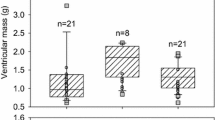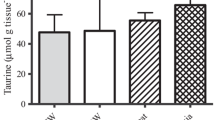Summary
Isometric tension development by ventricular strips of 9 species of teleosts, a frog and a turtle was assessed at varying contraction frequencies and Cao (external calcium concentration). With teleost hearts an increase in contraction frequency at constant Cao was always associated with a decrease in tension development; however, under comparable conditions a positive staircase was exhibited by the frog and turtle heart preparations. The reaction of the teleost heart was thus very different from the well established response of the hearts of higher vertebrates. Elevations in Cao always resulted in an increase in tension development such that the positive inotropic effect of Cao could compensate for the negative effect of a high contraction frequency.
Perfused isolated cod hearts exhibited an increase in cardiac output and pressure development as a result of increases in Cao. At 30 contractions min−1 a transition from 1–2 mM Cao led to a 68% increase in performance defined as the product of cardiac output times pressure development. The response was in excess of that of ventricular strips. At low Cao increases in rate from in situ resting levels to the high end of the physiological range resulted in a decrease in performance. Increases in Cao were able to ameliorate the detrimental effect of high imposed contraction frequency.
In conclusion, both ventricular strip and perfused heart experiments show that a positive inotropic effect of increased Cao can compensate for or even surpass the negative effect of high contraction frequency when both variables are at physiological levels. This finding could have relevance to the maintenance of cardiac performance during/or following intense swimming when both heart rate and plasma calcium may be elevated.
Similar content being viewed by others
Abbreviations
- TPT :
-
time to peak tension
References
Beamish FWH (1978) Swimming capacity. In: Hoar WS, Randall DJ (eds) Fish physiology, vol 7. Academic Press, New York, pp 101–187
Blinks, JR, Koch-Weiser J (1963) Analysis of the effects of changes in rate and rhythm upon myocardial contractility. J Pharma Exp Ther 135:373–389
Driedzic WR (1983) The fish heart as a model system for the study of myoglobin. Comp Biochem Physiol 76A:487–493
Driedzic WR, Scott DL, Farrell AP (1983) Acrobic and anaerobic contributions to energy metabolism in perfused isolated sea raven (Hemitripterus americanus) hearts. Can J Zool 61:1880–1883
Farrell AP, Heart T, Wood S, Driedzic WR (1984) The effect of extracellular calcium and preload on a teleost heart during extracellular hypercapnic acidosis. Can J Zool 62:1429–1435
Gesser H (1977) The effect of hypoxia and reoxygenation of force development in myocardia of carp and rainbow trout: protective effects of CO2/HCO3. J Exp Biol 69:199–206
Gesser H, Jørgensen E (1982) pH1, contractility and Ca-balance under hypercapnic acidosis in the myocardium of different vertebrate species. J Exp Biol 96:405–412
Gesser H, Poupa O (1978) The role of intracellular Ca2+ under hypercapnic acidosis of cardiac muscle: comparative aspects. J Comp Physiol 127:307–313
Johnson EA (1979) Force-interval relationship of cardiac muscle. In: Berne RM (ed) Handbook of physiology, Section 2, The Cardiovascular system, vol 1. American Physiological Society, Bethesda, pp 475–496
Jones DR, Randall DJ (1978) The respiratory and circulatory systems during exercise. In: Hoar WS, Randall DJ (eds) Fish physiology, vol 7. Academic Press, New York, pp 425–502
Jones DR, Langille BL, Randall DJ, Shelton G (1974) Blood flow in dorsal and ventral aortas of the cod,Gadus morhua. Am J Physiol 226:90–95
Kahn ML, Kavaler F, Fisher VJ (1976) Frequency-force relationships of mammalian ventricular muscle in vivo and in vitro. Am J Physiol 230:631–636
Leonard E, Hajdu S (1962) Action of electrolytes and drugs on the contractile mechanism of cardiac muscle cell. In: Hamilton WF (ed) Handbook of physiology, Section 2, Circulation, vol 1. American Physiological Society, Washington, pp 151–197
Maylie JM, Nunzi MG, Morad M (1979) Excitation-contraction coupling in ventricular muscle of dogfish (Squalus acanthias). Mt Desert Island Biol Lab Bull 19:84–87
Niedergerke R (1956) The staircase phenomenon and the action of calcium on the heart. J Physiol 134:569–583
Ruben JA, Bennett AF (1981) Intense exercise, bone structure, and blood calcium levels in vertebrates. Nature 291:411–413
Author information
Authors and Affiliations
Rights and permissions
About this article
Cite this article
Driedzic, W.R., Gesser, H. Ca2+ protection from the negative inotropic effect of contraction frequency on teleost hearts. J Comp Physiol B 156, 135–142 (1985). https://doi.org/10.1007/BF00692936
Accepted:
Issue Date:
DOI: https://doi.org/10.1007/BF00692936




